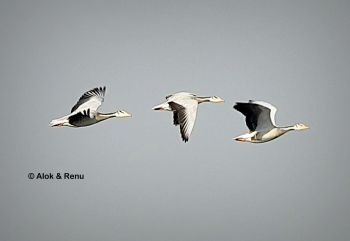- Anser indicus
Identification
68-78 cm (26¾-30¾ in)
- Pale grey
- Two black bars on white head
- Dark grey hind neck
- Bill and legs orangey-yellow
Distribution

Photo © by Alok Tewari
Dighal Village, Dist. Jhajjar, Haryana, India, November-2014
Alpine lakes in central Asia; winters to India and Burma.
Migration takes them high over the Himalayas.
European populations are generally escaped captive birds.
Taxonomy
This is a monotypic species[1].
Habitat
They breed near high altitude lakes. Wintering on salt and fresh water marshes, grazing in grassland and wetlands.
Behaviour
Breeding
They lay 3-8 eggs in a ground nest.
Diet
In summer the diet includes grass; in winter they feed on barley, rice and wheat.

Photo © by Alok Tewari
Dighal Village, District Jhajjar, Haryana, India, 13 December 2022
Vocalisation
Recording by Alok Tewari
National Chambal Sanctuary (Uttar Pradesh), Morena, M.P. Division, India Jan-2014
Call recorded as a flock flew over-head during boat-safari.
References
- Clements, J. F., T. S. Schulenberg, M. J. Iliff, D. Roberson, T. A. Fredericks, B. L. Sullivan, and C. L. Wood. 2018. The eBird/Clements checklist of birds of the world: v2018. Downloaded from http://www.birds.cornell.edu/clementschecklist/download/
- Collins Bird Guide ISBN 0 00 219728 6
- BF Member observations
Recommended Citation
- BirdForum Opus contributors. (2025) Bar-headed Goose. In: BirdForum, the forum for wild birds and birding. Retrieved 9 May 2025 from https://www.birdforum.net/opus/Bar-headed_Goose
External Links
GSearch checked for 2020 platform.1




